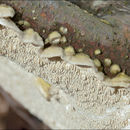en
names in breadcrumbs


Guidance for identification
Irpex lacteus is a common crust fungus distributed throughout temperate areas of the world. It is the type of the genus Irpex. Irpex lacteus is considered a polypore, but depending on growth conditions it can also produce a hydnoid hymenophore. Due to this variability and abundance of the species it has been described as a new species to science numerous times and subsequently has an extensive synonymy. The complete genome sequence of Irpex lacteus was reported in 2017.[1]
Irpex lacteus is a white-rot fungus that inhabits mainly angiosperm branches and trunks.[2] It is one of the most common wood-rotting fungi for instance in urban North America. It is inedible.[3] The fungus has been identified as a cause of pulmonary infections in immuno-compromised humans.[4]
The fungus was first described in 1818 by Elias Magnus Fries, who called it Sistotrema lacteum.[5] Fries later made it the type species of the genus Irpex in 1828.[6]
Irpex lacteus is a common crust fungus distributed throughout temperate areas of the world. It is the type of the genus Irpex. Irpex lacteus is considered a polypore, but depending on growth conditions it can also produce a hydnoid hymenophore. Due to this variability and abundance of the species it has been described as a new species to science numerous times and subsequently has an extensive synonymy. The complete genome sequence of Irpex lacteus was reported in 2017.
Irpex lacteus is a white-rot fungus that inhabits mainly angiosperm branches and trunks. It is one of the most common wood-rotting fungi for instance in urban North America. It is inedible. The fungus has been identified as a cause of pulmonary infections in immuno-compromised humans.
Cost capìtol a l'é mach në sbòss. Da finì.
A chërs an dzora a branch e bion ëd latifeuje.
![]() A venta mai mangé un bolè trovà se un a l'é nen un bon conossidor dij bolè!
A venta mai mangé un bolè trovà se un a l'é nen un bon conossidor dij bolè!
As peul nen mangesse.
Irpex lacteus (Fr.) Fr.
Cost capìtol a l'é mach në sbòss. Da finì.
AmbientA chërs an dzora a branch e bion ëd latifeuje.
Comestibilità![]() A venta mai mangé un bolè trovà se un a l'é nen un bon conossidor dij bolè!
A venta mai mangé un bolè trovà se un a l'é nen un bon conossidor dij bolè!
As peul nen mangesse.
И́рпекс моло́чно-бе́лый (лат. Irpex lacteus) — вид грибов, входящий в род Ирпекс (Irpex). Один из самых широко распространённых грибов в мире, вызывает белую гниль древесины.
Плодовые тела однолетние, распростёртые или с небольшим шляпочным отгибом, черепитчато сливающиеся, кожистые. Верхняя поверхность отгиба бороздчатая, опушённая, белая или сероватая, затем буреющая. Край плёнчатый, часто более светлый. Ткань белого цвета, тонкая, до 0,5 мм (редко до 2 мм) толщиной.
Гименофор изначально трубчатый, трубочки часто расщепляются, приобретая вид неправильных пластинок или шипиков, обычно характерно концентрически расположенных. Цвет белый, затем изменяется до светло-кремового.
Гифальная система димитическая. Гифы гименофора тонкостенные, ветвистые, неокрашенные, без пряжек. Гифы трамы толстостенные, неветвящиеся. Цистиды булавовидные. Базидии 2—4-споровые, булавовидной формы. Споры цилиндрические до продолговато-цилиндрических, 50—130×4—8 мкм.
Ирпекс не содержит каких-либо ядовитых веществ, однако его жёсткие тонкие плодовые тела не дают причислять его к съедобным грибам.
Ирпекс молочно-белый внешне напоминает некоторые виды рода Стекхеринум, однако для них характерен первично шиповатый гименофор, а не трубчатый, как у ирпекса. Первично трубчатый гименофор, затем превращающийся в шиповатый, характерен для рода Трихаптум, в окраске видов которого обычно присутствует фиолетовый оттенок.
Ирпекс — космополит с очень широким ареалом. В России известен во всех регионах от Европейской части до Дальнего Востока.
Ирпекс молочно-белый — сапротроф, реже паразит, поражающий в основном лиственные деревья (Acacia, Acer, Alnus, Betula, Cornus, Corylus, Fagus, Frangula, Juglans, Populus, Prunus, Quercus, Sorbus, Tilia), изредка встречающийся и на хвойных (Picea, Pinus). Вызывает белую гниль.
Ирпекс молочно-белый был впервые описан Элиасом Магнусом Фрисом в 1818 году во втором томе Observatione mycologicae в сборном роде распростёртых грибов с шиповатым гименофором. В 1828 году в книге Elenchus fungorum выделен им же в отдельный род Irpex.
Ирпекс молочно-белый — единственный вид рода, произрастающий в умеренном поясе. Несколько видов известны их тропических регионов мира.
И́рпекс моло́чно-бе́лый (лат. Irpex lacteus) — вид грибов, входящий в род Ирпекс (Irpex). Один из самых широко распространённых грибов в мире, вызывает белую гниль древесины.